Asst. Prof. Dr. Ayşe pekrio ğlu Balkıs. Deformation



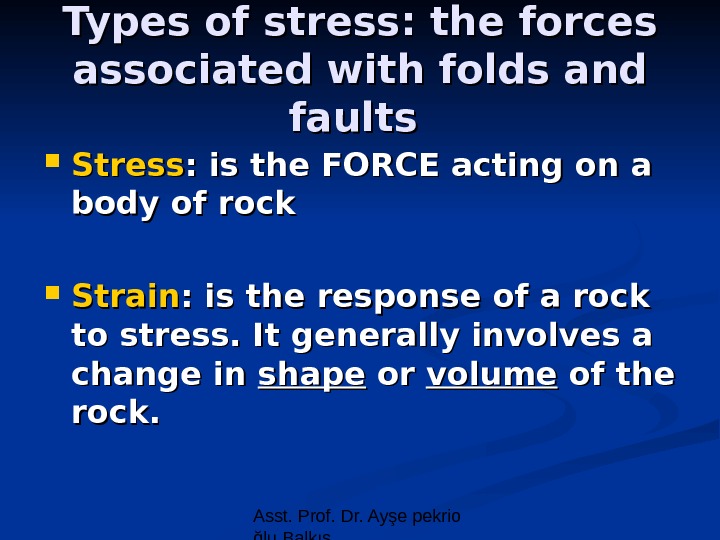













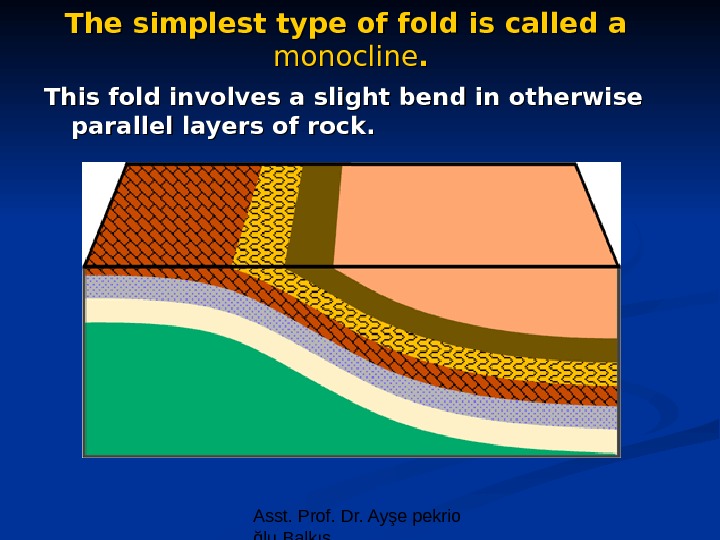



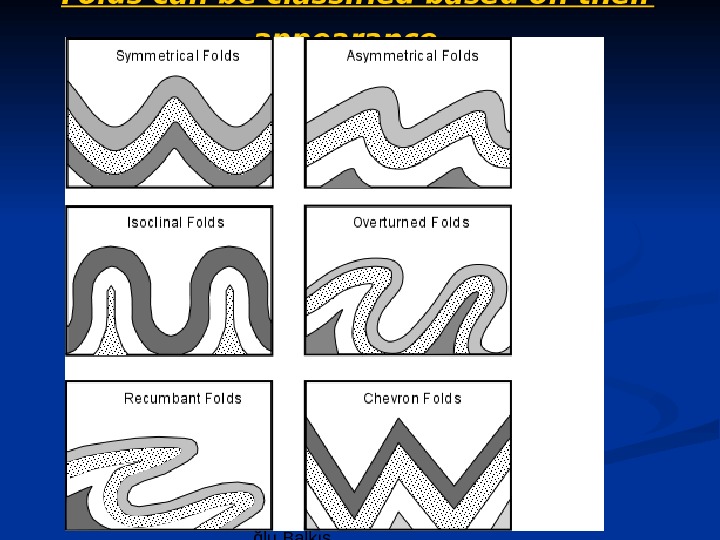







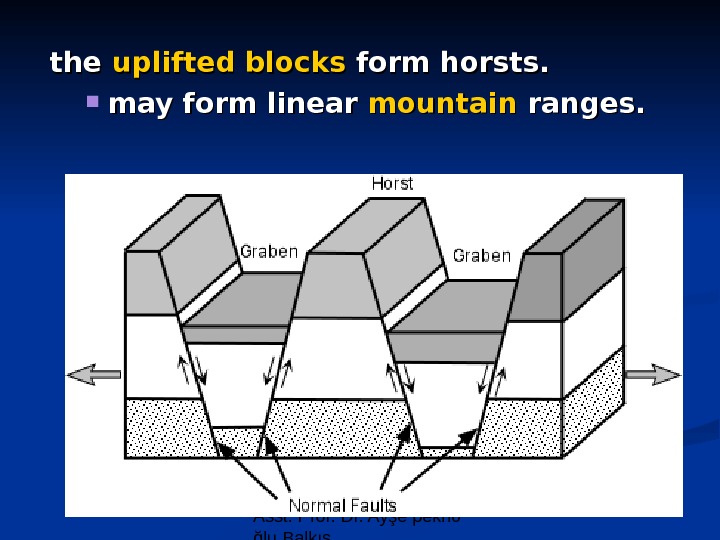
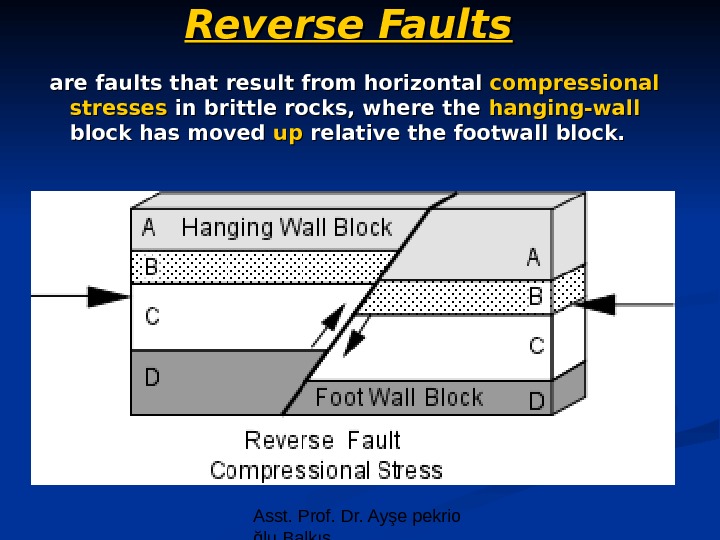


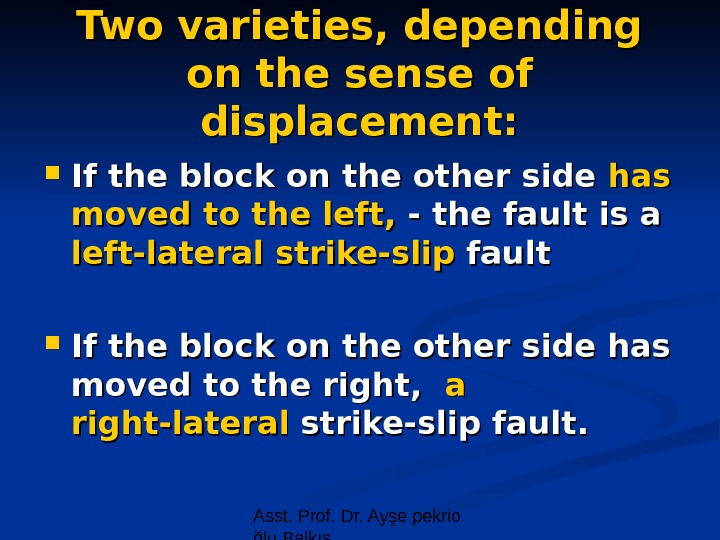

- Размер: 293.5 Кб
- Количество слайдов: 34
Описание презентации Asst. Prof. Dr. Ayşe pekrio ğlu Balkıs. Deformation по слайдам
 Asst. Prof. Dr. Ayşe pekrio ğlu Balkıs. Deformation of rocks
Asst. Prof. Dr. Ayşe pekrio ğlu Balkıs. Deformation of rocks
 Asst. Prof. Dr. Ayşe pekrioğlu Balkıs. How Rocks Become Deformed Rocks are deformed by: folding and faulting. . Deformation of rock involves changes in the shape and/or volume of these substances. Changes in shape and volume occur when stress and strain causes rock to buckle and fracture or crumple into folds.
Asst. Prof. Dr. Ayşe pekrioğlu Balkıs. How Rocks Become Deformed Rocks are deformed by: folding and faulting. . Deformation of rock involves changes in the shape and/or volume of these substances. Changes in shape and volume occur when stress and strain causes rock to buckle and fracture or crumple into folds.
 Asst. Prof. Dr. Ayşe pekrio ğlu Balkıs. Types of stress: the forces associated with folds and faults Stress : is the FORCE acting on a body of rock Strain : is the response of a rock to stress. It generally involves a change in shape or or volume of the rock.
Asst. Prof. Dr. Ayşe pekrio ğlu Balkıs. Types of stress: the forces associated with folds and faults Stress : is the FORCE acting on a body of rock Strain : is the response of a rock to stress. It generally involves a change in shape or or volume of the rock.
 Asst. Prof. Dr. Ayşe pekrio ğlu Balkıs. There are three types of of tectonic forces or stresses that deform rocks: Compressional forces Tensional forces Shearing forces
Asst. Prof. Dr. Ayşe pekrio ğlu Balkıs. There are three types of of tectonic forces or stresses that deform rocks: Compressional forces Tensional forces Shearing forces
 Asst. Prof. Dr. Ayşe pekrio ğlu Balkıs When stress is applied, rocks initially respond by deforming elastically. These are reversible changes. When the stress is removed, the rock returns to its original size and shape.
Asst. Prof. Dr. Ayşe pekrio ğlu Balkıs When stress is applied, rocks initially respond by deforming elastically. These are reversible changes. When the stress is removed, the rock returns to its original size and shape.
 Asst. Prof. Dr. Ayşe pekrio ğlu Balkıs. Once the elastic limit of the rock is exceeded by the stress, the rock will: 1. 1. Deform plastically , resulting in permanent changes in size and shape (such as folding), or 2. 2. Fracture (i. e. break)
Asst. Prof. Dr. Ayşe pekrio ğlu Balkıs. Once the elastic limit of the rock is exceeded by the stress, the rock will: 1. 1. Deform plastically , resulting in permanent changes in size and shape (such as folding), or 2. 2. Fracture (i. e. break)
 Asst. Prof. Dr. Ayşe pekrio ğlu Balkıs A A fracture is a crack in a rock. A A fault is a fracture along which movement has occurred.
Asst. Prof. Dr. Ayşe pekrio ğlu Balkıs A A fracture is a crack in a rock. A A fault is a fracture along which movement has occurred.
 Asst. Prof. Dr. Ayşe pekrio ğlu Balkıs Strata will break if rocks behave in a brittle fashion and/or confining pressure is low. When rocks that contain hard minerals like quartz or calcite are shallowly buried, it results in fractures. . Rocks nearer the surface of the Earth, where temperatures and pressures are lower , rocks will behave like a brittle solid and will fracture once their elastic limit is exceeded.
Asst. Prof. Dr. Ayşe pekrio ğlu Balkıs Strata will break if rocks behave in a brittle fashion and/or confining pressure is low. When rocks that contain hard minerals like quartz or calcite are shallowly buried, it results in fractures. . Rocks nearer the surface of the Earth, where temperatures and pressures are lower , rocks will behave like a brittle solid and will fracture once their elastic limit is exceeded.
 Asst. Prof. Dr. Ayşe pekrio ğlu Balkıs If strata are ductile and/or the confining pressure is high, deformation result in bending or folding. . Rocks will deform plastically and will fold under conditions of high temperatures and pressures, like those deep within the crust of the Earth. Rocks containing pliable (can be bent) minerals like gypsum or clays, or rocks that are deeply buried (>10 km depth) become folded when subjected to stress.
Asst. Prof. Dr. Ayşe pekrio ğlu Balkıs If strata are ductile and/or the confining pressure is high, deformation result in bending or folding. . Rocks will deform plastically and will fold under conditions of high temperatures and pressures, like those deep within the crust of the Earth. Rocks containing pliable (can be bent) minerals like gypsum or clays, or rocks that are deeply buried (>10 km depth) become folded when subjected to stress.
 Asst. Prof. Dr. Ayşe pekrio ğlu Balkıs. Whether a rock behaves in a a BRITTLE or or DUCTILE manner depends on: 1. 1. composition 2. 2. rate of stress high rate (fast) -> brittle behavior. 3. 3. temperature high temp (deep) -> ductile behavior 4. 4. pressure of overlying rocks high (deep) -> ductile behavior
Asst. Prof. Dr. Ayşe pekrio ğlu Balkıs. Whether a rock behaves in a a BRITTLE or or DUCTILE manner depends on: 1. 1. composition 2. 2. rate of stress high rate (fast) -> brittle behavior. 3. 3. temperature high temp (deep) -> ductile behavior 4. 4. pressure of overlying rocks high (deep) -> ductile behavior
 Asst. Prof. Dr. Ayşe pekrio ğlu Balkıs. Compressional forces – – squeeze and shorten bodies creating: anticlines, synclines and thrust faults. Associated with convergent boundaries. Compressional forces
Asst. Prof. Dr. Ayşe pekrio ğlu Balkıs. Compressional forces – – squeeze and shorten bodies creating: anticlines, synclines and thrust faults. Associated with convergent boundaries. Compressional forces
 Asst. Prof. Dr. Ayşe pekrio ğlu Balkıs. Tensional forces – – stretch a body and pull it apart, creating: normal or extensional faults. Associated with divergent boundaries where plates are moving apart.
Asst. Prof. Dr. Ayşe pekrio ğlu Balkıs. Tensional forces – – stretch a body and pull it apart, creating: normal or extensional faults. Associated with divergent boundaries where plates are moving apart.
 Asst. Prof. Dr. Ayşe pekrio ğlu Balkıs. Shearing forces – – push two sides of a body in opposite directions causing shearing zones in rocks and occurring at transform fault boundaries.
Asst. Prof. Dr. Ayşe pekrio ğlu Balkıs. Shearing forces – – push two sides of a body in opposite directions causing shearing zones in rocks and occurring at transform fault boundaries.
 Asst. Prof. Dr. Ayşe pekrio ğlu Balkıs. For plastic deformation of rock to occur a number of conditions must be met, including: The rock material must have the ability to deform under pressure and heat. The higher the temperature of the rock the more plastic it becomes. Pressure must not exceed the internal strength of the rock. If it does, fracturing occurs. Deformation must be applied slowly.
Asst. Prof. Dr. Ayşe pekrio ğlu Balkıs. For plastic deformation of rock to occur a number of conditions must be met, including: The rock material must have the ability to deform under pressure and heat. The higher the temperature of the rock the more plastic it becomes. Pressure must not exceed the internal strength of the rock. If it does, fracturing occurs. Deformation must be applied slowly.
 Asst. Prof. Dr. Ayşe pekrio ğlu Balkıs. Fold A A fold can be defined as a bend in rock that is the response to compressional forces. Folds are most visible in rocks that contain layering.
Asst. Prof. Dr. Ayşe pekrio ğlu Balkıs. Fold A A fold can be defined as a bend in rock that is the response to compressional forces. Folds are most visible in rocks that contain layering.
 Asst. Prof. Dr. Ayşe pekrio ğlu Balkıs. A number of different folds have been recognized and classified by geologists: Monocline Anticline Syncline
Asst. Prof. Dr. Ayşe pekrio ğlu Balkıs. A number of different folds have been recognized and classified by geologists: Monocline Anticline Syncline
 Asst. Prof. Dr. Ayşe pekrio ğlu Balkıs. The simplest type of fold is called a monocline. . This fold involves a slight bend in otherwise parallel layers of rock.
Asst. Prof. Dr. Ayşe pekrio ğlu Balkıs. The simplest type of fold is called a monocline. . This fold involves a slight bend in otherwise parallel layers of rock.
 Asst. Prof. Dr. Ayşe pekrio ğlu Balkıs. An An anticline is a convex up fold in rock that resembles an arch.
Asst. Prof. Dr. Ayşe pekrio ğlu Balkıs. An An anticline is a convex up fold in rock that resembles an arch.
 Asst. Prof. Dr. Ayşe pekrio ğlu Balkıs. A A syncline is a fold where the rock layers are warped downward.
Asst. Prof. Dr. Ayşe pekrio ğlu Balkıs. A A syncline is a fold where the rock layers are warped downward.
 Asst. Prof. Dr. Ayşe pekrio ğlu Balkıs. Synclinal folds in bedrock
Asst. Prof. Dr. Ayşe pekrio ğlu Balkıs. Synclinal folds in bedrock
 Asst. Prof. Dr. Ayşe pekrio ğlu Balkıs. Folds can be classified based on their appearance.
Asst. Prof. Dr. Ayşe pekrio ğlu Balkıs. Folds can be classified based on their appearance.
 Asst. Prof. Dr. Ayşe pekrio ğlu Balkıs Faults form in rocks when the stresses overcome the internal strength of the rock resulting in a fracture. Faults occur from both: tensional (shearing) and compressional forces.
Asst. Prof. Dr. Ayşe pekrio ğlu Balkıs Faults form in rocks when the stresses overcome the internal strength of the rock resulting in a fracture. Faults occur from both: tensional (shearing) and compressional forces.
 Asst. Prof. Dr. Ayşe pekrio ğlu Balkıs. Hanging wall and Footwall For any inclined fault plane: the block above the fault is the hanging wall block the block below the fault is the footwall block.
Asst. Prof. Dr. Ayşe pekrio ğlu Balkıs. Hanging wall and Footwall For any inclined fault plane: the block above the fault is the hanging wall block the block below the fault is the footwall block.
 Asst. Prof. Dr. Ayşe pekrio ğlu Balkıs. Different kinds of faults: These faults are named according to the type of stress that acts on the rock and by the nature of the movement of the rock blocks either side of the fault plane. Normal fault Reverse fault Thrust fault Strike-slip fault
Asst. Prof. Dr. Ayşe pekrio ğlu Balkıs. Different kinds of faults: These faults are named according to the type of stress that acts on the rock and by the nature of the movement of the rock blocks either side of the fault plane. Normal fault Reverse fault Thrust fault Strike-slip fault
 Asst. Prof. Dr. Ayşe pekrio ğlu Balkıs. Normal Faults are faults that result from horizontal tensional stresses in in brittle rocks. the hanging-wall block moves down relative to the footwall block
Asst. Prof. Dr. Ayşe pekrio ğlu Balkıs. Normal Faults are faults that result from horizontal tensional stresses in in brittle rocks. the hanging-wall block moves down relative to the footwall block
 Asst. Prof. Dr. Ayşe pekrio ğlu Balkıs. Normal Faults
Asst. Prof. Dr. Ayşe pekrio ğlu Balkıs. Normal Faults
 Asst. Prof. Dr. Ayşe pekrio ğlu Balkıs. Normal fault
Asst. Prof. Dr. Ayşe pekrio ğlu Balkıs. Normal fault
 Asst. Prof. Dr. Ayşe pekrio ğlu Balkıs. Grabens AND Horsts the down-dropped blocks form grabens -the grabens may form rift valleys: (The East African Rift Valley)
Asst. Prof. Dr. Ayşe pekrio ğlu Balkıs. Grabens AND Horsts the down-dropped blocks form grabens -the grabens may form rift valleys: (The East African Rift Valley)
 Asst. Prof. Dr. Ayşe pekrio ğlu Balkısthe uplifted blocks form horsts. may form linear mountain ranges.
Asst. Prof. Dr. Ayşe pekrio ğlu Balkısthe uplifted blocks form horsts. may form linear mountain ranges.
 Asst. Prof. Dr. Ayşe pekrio ğlu Balkıs. Reverse Faults are faults that result from horizontal compressional stresses in brittle rocks, where the hanging-wall block has moved upup relative the footwall block.
Asst. Prof. Dr. Ayşe pekrio ğlu Balkıs. Reverse Faults are faults that result from horizontal compressional stresses in brittle rocks, where the hanging-wall block has moved upup relative the footwall block.
 Asst. Prof. Dr. Ayşe pekrio ğlu Balkıs. AThrust Fault is a special case of a reverse fault where the dipdip of the fault is less than 15 oo and can result in older strata overlying younger strata.
Asst. Prof. Dr. Ayşe pekrio ğlu Balkıs. AThrust Fault is a special case of a reverse fault where the dipdip of the fault is less than 15 oo and can result in older strata overlying younger strata.
 Asst. Prof. Dr. Ayşe pekrio ğlu Balkıs. Strike Slip Faults relative motion on the fault has taken place along a horizontal direction. . result from shear stresses acting in the crust.
Asst. Prof. Dr. Ayşe pekrio ğlu Balkıs. Strike Slip Faults relative motion on the fault has taken place along a horizontal direction. . result from shear stresses acting in the crust.
 Asst. Prof. Dr. Ayşe pekrio ğlu Balkıs. Two varieties, depending on the sense of displacement: If the block on the other side has moved to the left, — the fault is a left-lateral strike-slip fault If the block on the other side has moved to the right, a a right-lateral strike-slip fault.
Asst. Prof. Dr. Ayşe pekrio ğlu Balkıs. Two varieties, depending on the sense of displacement: If the block on the other side has moved to the left, — the fault is a left-lateral strike-slip fault If the block on the other side has moved to the right, a a right-lateral strike-slip fault.
 Asst. Prof. Dr. Ayşe pekrio ğlu Balkıs. Strike Slip Faults
Asst. Prof. Dr. Ayşe pekrio ğlu Balkıs. Strike Slip Faults

